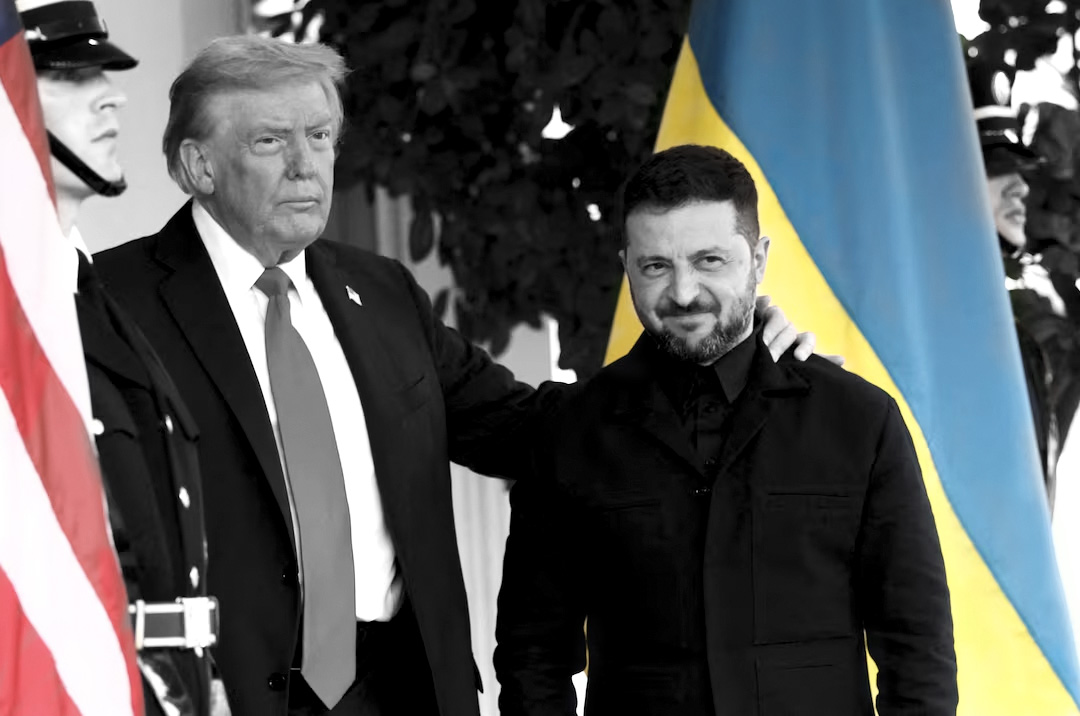Washington, D.C. — August 18, 2025
In a rare display of urgency, seven of Europe’s most powerful leaders joined Ukrainian President Volodymyr Zelensky at the White House today for talks with U.S. President Donald Trump. The meeting comes at a moment when the war in Ukraine stands at a paradigm of possibilities—one path pointing to a breakthrough toward peace, another to a dangerous escalation that could redraw Europe’s security map for decades [Guardian].
A Rare Diplomatic Convergence
Among those in Washington were UK Prime Minister Keir Starmer, French President Emmanuel Macron, German Chancellor Friedrich Merz, Italian Prime Minister Giorgia Meloni, Finnish President Alexander Stubb, NATO Secretary-General Mark Rutte, and European Commission President Ursula von der Leyen [Reuters].
Such a gathering on such short notice is nearly unprecedented, underscoring the gravity of Ukraine’s position and the urgency for Europe to assert itself in shaping any potential settlement. Analysts note that the combined presence of this many European heads of government in Washington signals that decisions made today could define the future of NATO and Europe’s security order [AP].
A Carefully Timed Agenda
The White House confirmed that Zelensky met privately with Trump in the Oval Office at 1:15 p.m. EDT, followed by a joint session at 3:00 p.m. EDT in the East Room that included European leaders [Time]. This sequencing highlights Washington’s strategy: address U.S.–Ukraine bilateral concerns first, then broaden the discussion with allies to present a more unified front.
What’s at Stake: Security Guarantees vs. Concessions
The central debate is whether Ukraine will gain enforceable security guarantees without conceding territory. Trump has previously floated the idea that Ukraine should abandon its NATO ambitions and drop its claim to Crimea [Washington Post]. European leaders, however, remain united in rejecting such concessions, pushing instead for NATO-style guarantees that defend Ukraine’s sovereignty while avoiding direct alliance membership.
Secretary of State Marco Rubio described the talks as “partnership negotiations,” but warned that both sides must accept “mutual concessions.” European officials, however, emphasized they came not to negotiate away Ukraine’s rights but to anchor its defense in long-term Western commitments.
Best- and Worst-Case Scenarios
Analysts outline two sharply different outcomes:
- Best-case: The U.S. and Europe agree on binding security guarantees, new aid commitments, and a framework for peace that leaves Ukraine whole and sovereign.
- Worst-case: Moscow’s preferences gain traction, pushing Ukraine to forfeit NATO membership or territory in exchange for a fragile ceasefire. Such concessions could fracture transatlantic unity and embolden further Russian demands.
Pressure on Zelensky
Zelensky enters the talks with high stakes on his shoulders. A repeat of his February confrontation with Trump—when raised voices nearly jeopardized U.S. aid—could risk future American support. European leaders’ presence acts as a buffer, ensuring Ukraine faces diplomatic pressure collectively, not alone.
Europe’s Costs and Commitments
Europe has already contributed approximately €132 billion in combined military, financial, and humanitarian support since the start of the war. Looking ahead, analysts warn that a post-war security framework could raise defense spending across Europe to 3–5% of GDP and require deployments of up to 200,000 troops [Wikipedia].
Despite the financial and political burden, European leaders continue to stress their resolve. At the London Summit earlier this year, they pledged ongoing aid and formed a “coalition of the willing” to ensure Ukraine’s sovereignty is not traded away for short-term peace.
Conclusion: Unity or Fracture?
Today’s White House summit may prove decisive. If Western leaders hold firm, Ukraine could gain credible guarantees that stabilize its future. If cracks appear, concessions may shift the balance toward Moscow and weaken the transatlantic alliance.
For Zelensky, the presence of Europe’s most powerful leaders is both protection and pressure. For Trump, it is a test of his ability to balance diplomacy with allies and his own overtures to Russia. And for Europe, it is a moment of reckoning—whether to stand together or risk division at a crossroads in history.
Quick Q&A
Who are the European leaders meeting in Washington?
Top European leaders joined President Zelensky for talks with the U.S. President, reflecting an unusual, short-notice display of allied coordination.
Why is the timing significant?
Back-to-back bilateral and multilateral sessions signal urgency and an attempt to balance U.S.–Ukraine talks with broader allied alignment.
What outcomes are on the table?
Potential NATO-style security guarantees for Ukraine without territorial concessions vs. pressure for concessions in exchange for a ceasefire framework.
How committed is Europe, and at what cost?
European support remains strong; however, sustained aid and higher defense spending represent a significant long-term burden.
Sources & Methodology
All information in this article is drawn from publicly available reports from Reuters, AP News, The Guardian, Washington Post, and Time. Figures on European aid and troop commitments are based on official government statements and credible reporting. This article was edited to ensure accuracy, clarity, and balance for alternative news perspectives.

[…] D.C. – In a high-stakes White House summit, U.S. President Donald Trump convened with Ukrainian President Volodymyr Zelenskyy and key European […]
[…] European Leaders Rally in Washington: Zelensky, Trump and Allies Forge United Front […]
Thank you for your comment.
[…] D.C. – In a high-stakes White House summit, U.S. President Donald Trump convened with Ukrainian President Volodymyr Zelenskyy and key European […]
Do you agree that he acted like the “leader of leaders” ?